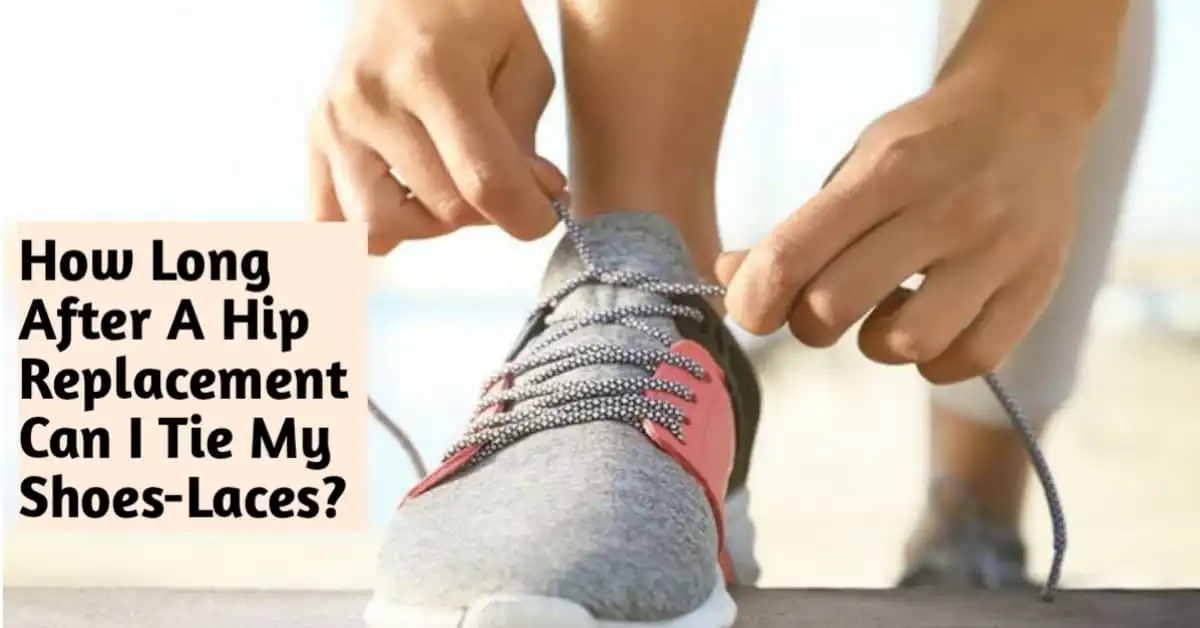After undergoing hip replacement surgery, it’s common to wonder when you’ll be able to perform certain activities, such as tying your shoelaces. The answer varies depending on multiple factors, including your individual recovery progress and adherence to post-surgery instructions.
In this article, we will provide you with valuable information on the recovery process after a hip replacement, factors that can affect your shoe-lace-tying ability and tips for making the process easier.
Also Read: How To Make a Shoe Smaller?
How Long After a Hip Replacement Can I Tie My Shoe-Laces?
The time it takes to be able to tie your shoelaces after a hip replacement depends on the type of surgery you had and your individual recovery.
- Posterior approach: This is the more traditional approach, and it involves making an incision in the back of the hip. It takes longer to recover from this type of surgery, and most patients are advised to wait 6–8 weeks before tying their shoelaces.
- Anterior approach: This is a newer approach that involves making an incision in the front of the hip. It is associated with a shorter recovery time, and some patients may be able to tie their shoelaces as soon as 2-4 weeks after surgery.
Understanding Hip Replacement Surgery
A hip replacement involves the surgical removal of damaged or arthritic parts of the hip joint and replacing them with artificial components. The surgery aims to reduce pain, increase joint functionality, and enhance overall mobility.
Recovery Timeline
3.1 Initial Recovery Phase
In the first few weeks post-surgery, the focus is on wound healing and regaining basic movement. During this phase, you might not be able to bend or flex the operated hip extensively. Tying shoe laces might be a challenge due to restricted motion.
3.2 Intermediate Phase
As you progress to this phase (usually around 6-8 weeks after surgery), you’ll notice improved mobility. Physical therapy plays a vital role in helping you regain strength and flexibility. However, activities involving extreme bending or sudden movements should still be approached with caution.
3.3 Advanced Recovery Phase
Around 3–6 months after the surgery, most patients experience a substantial improvement in hip function. Tying shoelaces becomes easier, but it’s important to remember that each person’s recovery journey is unique. Consulting your healthcare provider before attempting certain activities is crucial.
Factors Affecting Recovery
Several factors influence the pace of your recovery. Age, overall health, adherence to post-operative guidelines, and the type of hip replacement procedure all play a role. It’s essential to be patient with yourself and not rush into activities that could hinder your progress.
When Can You Tie Your Shoe-Laces?
The ability to tie shoe laces comfortably varies from person to person. On average, most patients can resume this activity independently around the 2 to 3-month mark. However, it’s advisable to utilize adaptive tools like long-handled shoe horns or slip-on shoes during the initial stages of recovery.
Tips for Tying Shoe-Laces After Hip Replacement
- Opt for shoes with Velcro straps or elastic laces for easier wear.
- Sit on a stable surface while tying your shoelaces to avoid unnecessary strain.
- Consider using assistive devices if needed, such as a reacher or dressing stick.
- Don’t hesitate to ask for assistance if you experience discomfort or difficulty.
Ensuring a Successful Recovery
Adhering to Physical Therapy
Engaging in regular physical therapy exercises prescribed by your healthcare provider significantly aids in your recovery journey. These exercises target muscle strength, joint mobility, and overall stability.
Following Doctor’s Recommendations
Your surgeon’s recommendations are invaluable. They understand your unique case and can provide personalized advice on when to resume specific activities like driving, exercising, and even tying your shoelaces.
Listen to Your Body
Throughout your recovery, it’s vital to stay attuned to your body’s signals. If an activity causes pain or discomfort, it’s a sign to ease off and give yourself more time before attempting it again.
FAQs
Can I cross my legs after a hip replacement?
Crossing your legs might strain the hip joint during the early recovery phases. It’s best to avoid this movement until your healthcare provider gives you the green light.
When can I drive again?
Driving should typically be avoided for about 4-6 weeks post-surgery or until you can comfortably control the vehicle without pain or stiffness.
Is it safe to bend over to pick up objects?
Bending over at the waist can stress the hip joint. Instead, try bending your knees to lower yourself when picking up objects.
Can I resume sports and physical activities?
Engaging in high-impact sports or activities might be restricted, especially in the early recovery stages. Consult your doctor before resuming any physical activities.
How long until I can sit on a normal chair?
Sitting on a regular chair is usually feasible a few weeks after surgery. Just remember to sit with proper posture and use cushions if needed for added comfort.
Conclusion
Recovering from hip replacement surgery can be a lengthy process, but it is important to remember that everyone heals at their own pace. Don’t rush the process – give your body the time it needs to heal properly. Stick to your physical therapy routine and follow your doctor’s instructions to ensure a successful recovery.
When it comes to tying your shoe laces, it is typically safe to do so once weight-bearing restrictions are lifted and the hip joint is stable, around 6 to 8 weeks post-surgery. However, this timeline can vary depending on individual factors and recovery progress.
If you find it challenging to tie your shoelaces, there are alternative options, such as velcro shoes or slip-on shoes, that can provide added convenience and comfort. Consider talking to your doctor or physical therapist about what shoe options may work best for you.
Remember, regaining full mobility after hip replacement surgery takes time and patience. Be kind to yourself and celebrate all the small successes along the way. Soon enough, you’ll be tying your shoelaces with ease and returning to your normal daily activities.
